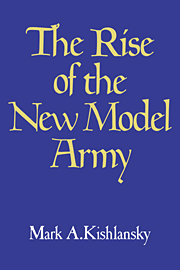3 - The Triumph of the New Model Army
Published online by Cambridge University Press: 17 September 2009
Summary
The success is hardly imaginable which accompanies Sir Thomas Fairfax's army.
The campaign of 1645 dawned darkly. The reorganization of Parliament's southern forces was barely completed before the royalists were in the field. Hopes that the spirit of reform that resulted in self-denial would spread to military matters quickly dimmed. “I pray God this poor Kingdom pays not too dear for this New Model,” one of the discarded parliamentary commanders wrote. At the Committee of Both Kingdoms the philosophical and personal differences that had stamped the first years of fighting weighed heavily in debates over strategy. Plans for war were formulated, reformulated, and changed again as the weakness of Fairfax's forces and the refusal of the Scots to move south became apparent. Scottish obduracy was particularly galling, for Leven's men represented the safeguard upon which the Committee had relied in deciding to recast the English armies. When the Scots declined to join Association forces raised by Cromwell, the twin beacons of reform – the unification of the English armies and the elimination of recriminations – were put out. Detachments of the New Model were sent west to relieve Taunton and east to guard the Association, and its core was ordered to blockade Oxford. On June 1 Parliament suffered its worst defeat yet, the siege and sack of Leicester.
The failure of reform initially to reverse Parliament's military fortunes, and thus God's judgment reflected in that failure, heightened the disputes that new modeling essayed to dispel.
- Type
- Chapter
- Information
- The Rise of the New Model Army , pp. 52 - 75Publisher: Cambridge University PressPrint publication year: 1980



